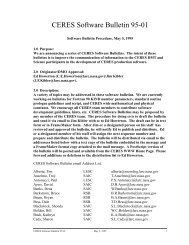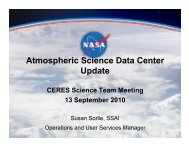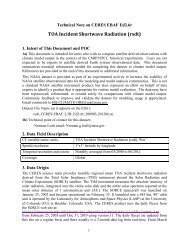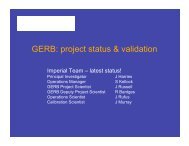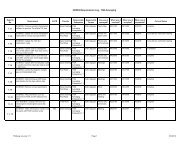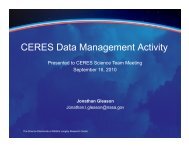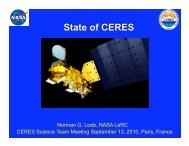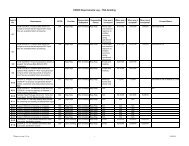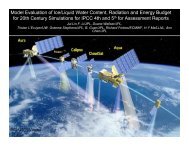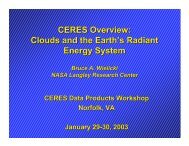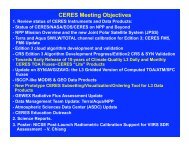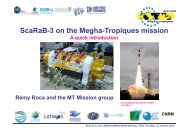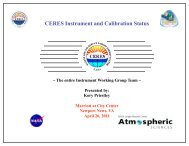CERES Science Requirements Specification - NASA
CERES Science Requirements Specification - NASA
CERES Science Requirements Specification - NASA
Create successful ePaper yourself
Turn your PDF publications into a flip-book with our unique Google optimized e-Paper software.
Clouds and the Earth’s Radiant Energy System<br />
(<strong>CERES</strong>)<br />
<strong>Science</strong> <strong>Requirements</strong> <strong>Specification</strong><br />
Version 1<br />
for<br />
National Polar-orbiting Operational Environmental Satellite<br />
System (NPOESS) Preparatory Project<br />
(NPP)<br />
<strong>Science</strong> Data Segment<br />
(SDS)<br />
Earth Radiation Budget (ERB)<br />
Climate Analysis Research System (CARS)<br />
June 2009
<strong>Science</strong> <strong>Requirements</strong> <strong>Specification</strong> V1 6/25/2009<br />
Document Revision Record<br />
The Document Revision Record contains information pertaining to document changes. The table<br />
lists the Version Number, the date of the last revision, a short description of the revision, and the<br />
revised sections. The primary contributors to this document are listed in the Acknowledgements<br />
section.<br />
Document Revision Record<br />
Version<br />
Number<br />
Date<br />
Description of Revision<br />
Section(s)<br />
Affected<br />
V0.1 10/23/2008 • Initial version. All<br />
V0.2 11/07/2008 • Modifications based on first peer review. All<br />
V0.3 12/04/2008 • Modifications based on second peer review. All<br />
V0.4 12/18/2008 • Modifications based on third peer review. All<br />
V0.5 01/08/2009 • Modifications based on fourth peer review. All<br />
V0.6 01/14/2009 • Modified wording. Secs. 1.0, 1.1,<br />
2.1.2.1, 2.4.1,<br />
2.4.2, 2.4.3, 2.4.4,<br />
2.4.4.1, 2.4.5, &<br />
2.4.5.3<br />
V0.7 01/20/2009 • Changed “ASDC” to “ERB CARS”<br />
• Changed “ERB CARS” to “ASDC”<br />
Sec. 2.1.3<br />
Secs. 2.3.3.1,<br />
2.3.3.2, 2.3.4,<br />
2.3.4.1, & 2.3.4.2<br />
• Changed “Data Management Team” to “DMT” Sec. 2.4.5.1<br />
V0.8 04/01/2009 • Modifications based on peer review with ASDC. All<br />
V1 06/25/2009 • Final edit – <strong>CERES</strong> Documentation Team. All<br />
iv
<strong>Science</strong> <strong>Requirements</strong> <strong>Specification</strong> V1 6/25/2009<br />
Preface<br />
The objective of the ERB CARS, which consists of the <strong>CERES</strong> <strong>Science</strong> Team, the <strong>CERES</strong><br />
DMT, and the ASDC, is to extend the <strong>CERES</strong> climate record using data from the FM5<br />
instrument on NPP. The <strong>CERES</strong> DMT works with the <strong>CERES</strong> <strong>Science</strong> Team to develop the<br />
software necessary to support the science algorithms. The DMS software is released to the<br />
Langley ASDC where it is run in the production environment to produce an extensive set of<br />
science data products. The DMS consists of 12 subsystems each of which contains one or more<br />
PGEs.<br />
The purpose of the <strong>CERES</strong> <strong>Science</strong> <strong>Requirements</strong> <strong>Specification</strong> is to show the expansion of the<br />
<strong>CERES</strong> Level-4 data management and processing requirements from the NPP SDS Level-3 ERB<br />
CARS requirements.<br />
The <strong>CERES</strong> Data Management Plan provides overall guidance to the <strong>CERES</strong> DMT.<br />
v
<strong>Science</strong> <strong>Requirements</strong> <strong>Specification</strong> V1 6/25/2009<br />
Acknowledgements<br />
This document reflects the collaborative efforts of the <strong>CERES</strong> DMT (in conjunction, as<br />
appropriate, with the <strong>CERES</strong> <strong>Science</strong> Team). The primary contributors to this document are:<br />
<strong>NASA</strong> – Erika B. Geier<br />
SSAI – James W. Closs, Walter F. Miller, John L. Robbins<br />
Documentation support was provided by the <strong>CERES</strong> Documentation Team (Tammy O. Ayers<br />
(SSAI) and Joanne H. Saunders (SSAI)).<br />
Erika B. Geier (<strong>NASA</strong>) is the <strong>CERES</strong> DMT Lead. At the time of publication of this document<br />
members of the <strong>CERES</strong> DMT from SSAI are:<br />
J. Ashley Alford Walter F. Miller<br />
Tammy O. Ayers<br />
Le Trang Nguyen<br />
Mark J. Bowser<br />
Rajalekshmy I. Raju<br />
Ricky R. Brown<br />
John L. Robbins<br />
Thomas E. Caldwell<br />
Joanne H. Saunders<br />
Churngwei Chu<br />
Rita A. Smith<br />
Lisa H. Coleman<br />
K. Dianne Snyder<br />
Denise L. Cooper<br />
Victor E. Sothcott<br />
Elizabeth D. Filer<br />
Szedung Sun-Mack<br />
Arthur T. Grepiotis<br />
Mark G. Timcoe<br />
Carla O. Grune<br />
Dale R. Walikainen<br />
Elizabeth C. Heckert<br />
Scott M. Zentz<br />
Brian E. Magill<br />
Several members of the LaRC ASDC also contributed to this document. These review team<br />
members are:<br />
Ronnie E. Gillian<br />
Christopher J. Harris<br />
John M. Kusterer<br />
Michael M. Little<br />
James D. McCabe<br />
Jessie L. Orozco<br />
Pamela L. Rinsland<br />
Alan D. Settell<br />
Susan E. Sorlie<br />
Susan Thomas (SSAI) of the Instrument Calibration/Validation Team also contributed to this<br />
document.<br />
vi
<strong>Science</strong> <strong>Requirements</strong> <strong>Specification</strong> V1 6/25/2009<br />
Section<br />
TABLE OF CONTENTS<br />
Page<br />
Document Revision Record ............................................................................................................ ii<br />
Preface............................................................................................................................................. v<br />
Acknowledgements........................................................................................................................ vi<br />
1.0 Introduction.......................................................................................................................... 1<br />
1.1 Purpose............................................................................................................................. 1<br />
1.2 Background ...................................................................................................................... 2<br />
1.3 Scope ................................................................................................................................ 2<br />
2.0 ERB CARS <strong>Requirements</strong> <strong>Specification</strong>............................................................................. 5<br />
2.1 <strong>CERES</strong> FM5 Instrument Support..................................................................................... 5<br />
2.1.1 Support for FM5 Instrument Calibration .................................................................. 5<br />
2.1.2 Archive of Correlative Observations ........................................................................ 5<br />
2.1.3 Archive of Calibration Parameters............................................................................ 6<br />
2.2 Interfaces .......................................................................................................................... 6<br />
2.2.1 Land PEATE Interface.............................................................................................. 6<br />
2.3 Data Receipt ..................................................................................................................... 6<br />
2.3.1 <strong>CERES</strong> RDR Ingest .................................................................................................. 6<br />
2.3.2 VIIRS SDR Ingest..................................................................................................... 7<br />
2.3.3 VIIRS EDR Ingest .................................................................................................... 7<br />
2.3.4 Ancillary Data Ingest ................................................................................................ 8<br />
2.3.5 Monitoring Ingest...................................................................................................... 9<br />
2.4 Data Products ................................................................................................................... 9<br />
2.4.1 <strong>CERES</strong> Bi-Directional Scan (BDS).......................................................................... 9<br />
2.4.2 <strong>CERES</strong> ERBE-like Instantaneous TOA Estimates (ES-8) ..................................... 10<br />
vii
<strong>Science</strong> <strong>Requirements</strong> <strong>Specification</strong> V1 6/25/2009<br />
Section<br />
TABLE OF CONTENTS<br />
Page<br />
2.4.3 <strong>CERES</strong> ERBE-like Monthly Regional (ES-9) and Geographical (ES-4)<br />
Averages ................................................................................................................. 11<br />
2.4.4 Fused <strong>CERES</strong> Climate Data Records ..................................................................... 12<br />
2.4.5 <strong>CERES</strong> Data Distribution and User Support .......................................................... 13<br />
2.4.6 <strong>CERES</strong> Data Distribution to <strong>Science</strong> Team............................................................ 14<br />
2.5 Sub-sampler Software .................................................................................................... 14<br />
2.5.1 Sub-sampler Software Development ...................................................................... 14<br />
2.5.2 Sub-sampler Software Maintenance ....................................................................... 15<br />
3.0 References.......................................................................................................................... 16<br />
Appendix A - Acronyms............................................................................................................. A-1<br />
viii
<strong>Science</strong> <strong>Requirements</strong> <strong>Specification</strong> V1 6/25/2009<br />
LIST OF FIGURES<br />
Figure<br />
Page<br />
Figure 1-1. NPP <strong>CERES</strong> Data System Architecture...................................................................... 3<br />
Figure 1-2. <strong>CERES</strong> top-level data flow diagram with NPP-era inputs.......................................... 4<br />
ix
<strong>Science</strong> <strong>Requirements</strong> <strong>Specification</strong> V1 6/25/2009<br />
1.0 Introduction<br />
<strong>CERES</strong> is a key component of EOS and NPP. The first <strong>CERES</strong> instrument (PFM) flew on<br />
TRMM, four instruments are currently operating on the EOS Terra (FM1 and FM2) and Aqua<br />
(FM3 and FM4) platforms, and FM5 will fly on the NPP platform currently scheduled for launch<br />
in January 2011. <strong>CERES</strong> measures radiances in three broadband channels: a shortwave channel<br />
(0.3 - 5 μm), a total channel (0.3 - 200 μm), and an infrared window channel (8 - 12 μm). The<br />
last data processed from the PFM instrument aboard TRMM was March 2000; no additional data<br />
are expected. Until June 2005, one instrument on each EOS platform operated in a fixed azimuth<br />
scanning mode and the other operated in a rotating azimuth scanning mode; now all are typically<br />
operating in the fixed azimuth scanning mode. The NPP platform will carry the FM5 instrument,<br />
which will operate in the fixed azimuth scanning mode though it will have the capability to<br />
operate in a rotating azimuth scanning mode.<br />
<strong>CERES</strong> climate data records involve an unprecedented level of data fusion: <strong>CERES</strong><br />
measurements are combined with imager data (e.g., MODIS on Terra and Aqua, VIIRS on NPP),<br />
4-D weather assimilation data, microwave sea-ice observations, and measurements from five<br />
geostationary satellites to produce climate-quality radiative fluxes at the top-of-atmosphere,<br />
within the atmosphere and at the surface, together with the associated cloud and aerosol<br />
properties.<br />
The <strong>CERES</strong> project management and implementation responsibility is at <strong>NASA</strong> Langley. The<br />
<strong>CERES</strong> <strong>Science</strong> Team is responsible for the instrument design and the derivation and validation<br />
of the scientific algorithms used to produce the data products distributed to the atmospheric<br />
sciences community. The <strong>CERES</strong> DMT is responsible for the development and maintenance of<br />
the software that implements the science team’s algorithms in the production environment to<br />
produce <strong>CERES</strong> data products. The Langley ASDC is responsible for the production<br />
environment, data ingest, and the processing, archival, and distribution of the <strong>CERES</strong> data<br />
products.<br />
All acronyms used in this document are defined in Appendix A. They are not defined in the text<br />
unless quoted from an external document.<br />
1.1 Purpose<br />
The NPP SDS, in conjunction with <strong>CERES</strong>, developed the NPP SDS Level-3 requirements for<br />
<strong>CERES</strong> based on the Level-2 requirements on the NPP SDS from the NPP Project Office. The<br />
NPP SDS Level-3 requirements have been baselined and are under configuration control at the<br />
SDS as the “NPP <strong>Science</strong> Data Segment <strong>Requirements</strong> <strong>Specification</strong>” (see Reference 1).<br />
<strong>CERES</strong> has analyzed these Level-3 requirements and has further broken them down as Level-4<br />
<strong>CERES</strong> science requirements. The purpose of the “<strong>CERES</strong> <strong>Science</strong> <strong>Requirements</strong> <strong>Specification</strong>”<br />
is to document both the NPP SDS Level-3 requirements on <strong>CERES</strong> and the more detailed Level-<br />
4 requirements defined by the <strong>CERES</strong> team.<br />
1
<strong>Science</strong> <strong>Requirements</strong> <strong>Specification</strong> V1 6/25/2009<br />
1.2 Background<br />
The ERB CARS is the FM5 component of <strong>CERES</strong>. It is an element of the NPP SDS and<br />
leverages existing capabilities from the <strong>CERES</strong> <strong>Science</strong> Team, the <strong>CERES</strong> DMT, and the ASDC<br />
at LaRC. The SDS interfaces with the IDPS, the ADS, the C3S, and other ancillary data<br />
providers as illustrated in Figure 1-1.<br />
Modifications to Terra/Aqua processes to support the FM5 instrument on the NPP spacecraft<br />
involve close interactions with the SDS Land PEATE. The Land PEATE passes <strong>CERES</strong> RDRs<br />
directly to the ERB CARS where they are processed to produce Instrument and ERBE-like data<br />
products. The Land PEATE subsamples VIIRS radiance and geolocation data using software<br />
provided by <strong>CERES</strong> and sends the files to the ERB CARS.<br />
The VIIRS radiances are used to determine cloud properties that are matched with <strong>CERES</strong><br />
unfiltered radiances and used to calculate TOA and surface fluxes on the instantaneous SSF. A<br />
radiative transfer code is used to determine fluxes at five fixed levels in the atmosphere for the<br />
CRS. Parameters from both of these products are placed on a one-degree, equal-angle grid for<br />
each hour in the SFC and FSW, respectively. The final step is to time-interpolate and spaceaverage<br />
the gridded data to create global and zonal monthly products (SRBAVG, SYN, AVG,<br />
and ZAVG). Figure 1-2 illustrates the <strong>CERES</strong> top-level data flow and products described above.<br />
<strong>CERES</strong> data products are archived and made available for distribution to the user community<br />
along with Data Quality Summaries. User support is provided for all publicly-released <strong>CERES</strong><br />
data products. Section 3.0 of the <strong>CERES</strong> <strong>Science</strong> and Data Products Working Agreement (see<br />
Reference 2) contains details on resources provided to <strong>CERES</strong> by the NPP SDS. The <strong>CERES</strong><br />
Data Products Catalog (see Reference 3) contains complete parameter listings for the <strong>CERES</strong><br />
data products.<br />
1.3 Scope<br />
This document applies to the delivery, processing, validation, archiving, and distribution of<br />
<strong>CERES</strong> FM5 data. It is intended to document the Level-3 requirements from the NPP <strong>Science</strong><br />
Data Segment <strong>Requirements</strong> <strong>Specification</strong> (see Reference 1) that apply to the ERB CARS and<br />
the expansion of these Level-3 requirements into <strong>CERES</strong> Level-4 science requirements.<br />
2
<strong>Science</strong> <strong>Requirements</strong> <strong>Specification</strong> V1 6/25/2009<br />
Commands, Loads<br />
and Requests<br />
Mission Notices<br />
and Data<br />
<strong>CERES</strong><br />
Instrument<br />
Ops Team<br />
NPOESS Systems<br />
NPP Systems<br />
NOAA Systems<br />
<strong>CERES</strong> Systems<br />
Cmd<br />
&<br />
Tlm<br />
Svalbard<br />
C3S<br />
Mission<br />
Data<br />
RDRs to PST<br />
IDPS<br />
Mission Notices<br />
and Data Requests<br />
All RDRs<br />
All xDRs<br />
RDRs<br />
SDRs<br />
EDRs<br />
IPs<br />
SDS<br />
FTP<br />
SD3E<br />
ADS<br />
ERB<br />
CARS<br />
Data<br />
and<br />
<strong>Science</strong><br />
Operations<br />
<strong>CERES</strong><br />
RDRs,<br />
VIIRS<br />
Subsampled<br />
& Aerosols<br />
Land<br />
PEATE<br />
Existing Data<br />
Agreements<br />
Data<br />
Distribution<br />
Ancillary<br />
Data<br />
Providers<br />
Data<br />
Users<br />
Figure 1-1. NPP <strong>CERES</strong> Data System Architecture<br />
3
<strong>Science</strong> <strong>Requirements</strong> <strong>Specification</strong> V1<br />
6/25/2009<br />
INSTR:<br />
Conv. RDRs<br />
Preprocesser<br />
Output<br />
Geolocate<br />
and Calibrate<br />
Earth<br />
Radiances<br />
1<br />
BDS:<br />
BiDirectional<br />
Scans<br />
ERBE-like<br />
Inversion to<br />
Instantaneous<br />
TOA Fluxes<br />
2<br />
EID6:<br />
ERBE-like<br />
Regional<br />
Data<br />
ERBE-like<br />
Averaging to<br />
Monthly TOA<br />
Fluxes<br />
3<br />
IES: Instrument<br />
Earth Scans<br />
VIIRS<br />
Cloud<br />
Imager Data<br />
Determine<br />
Cloud<br />
Properties,<br />
TOA<br />
and Surface<br />
Fluxes<br />
4<br />
SSF: Single<br />
Scanner Footprint<br />
TOA/Surface<br />
Fluxes and<br />
Clouds<br />
CRH:<br />
Clear<br />
Reflectance<br />
History<br />
Grid TOA<br />
and Surface<br />
Fluxes:<br />
Clouds<br />
9<br />
ES-8:<br />
ERBE-like<br />
Instantaneous<br />
TOA Estimates<br />
ISCCP-D2like-<br />
Day/Nit:<br />
Monthly<br />
Gridded Cloud<br />
Averages<br />
SFC: Monthly<br />
Gridded<br />
TOA/Surface<br />
Fluxes and<br />
Clouds<br />
Compute<br />
Monthly and<br />
Regional TOA<br />
and Surface<br />
Averages<br />
10<br />
ES-9:<br />
ERBE-like<br />
Monthly<br />
Regional<br />
Averages<br />
ES-4:<br />
ERBE-like<br />
Monthly<br />
Geographical<br />
Averages<br />
SRBAVG:<br />
Monthly<br />
TOA/Surface<br />
Averages<br />
SURFMAP:<br />
Surface<br />
Map<br />
Compute<br />
Surface and<br />
Atmospheric<br />
Radiative<br />
Fluxes<br />
5<br />
CRS:<br />
Clouds<br />
and Radiative<br />
Swath<br />
MOA:<br />
Meteorological,<br />
Ozone, and<br />
Aerosol Data<br />
Regrid<br />
Humidity<br />
and<br />
Temperature<br />
Fields<br />
12<br />
MWH:<br />
Microwave<br />
Humidity<br />
APD:<br />
Aerosol<br />
Data<br />
GAP:<br />
Gridded<br />
Analysis<br />
Product<br />
OPD:<br />
Ozone<br />
Profile<br />
Data<br />
Grid<br />
Radiative<br />
Fluxes and<br />
Clouds<br />
6<br />
GGEO:<br />
Gridded GEO<br />
Narrowband<br />
Radiances, Clouds<br />
Grid GEO<br />
Narrowband<br />
Radiances,<br />
Clouds<br />
11<br />
GEO:<br />
Geostationary<br />
Narrowband<br />
Radiances<br />
Input differs based<br />
on satellite<br />
Subsystem<br />
Product<br />
FSW: Monthly<br />
Gridded<br />
Radiative<br />
Fluxes and<br />
Clouds<br />
Time<br />
Interpolate,<br />
Compute<br />
Fluxes<br />
7<br />
SYNI:<br />
Intermediate<br />
Synoptic<br />
Radiative<br />
Fluxes and<br />
Clouds<br />
ISCCP-D2like-<br />
GEO:<br />
Monthly Cloud<br />
Averages<br />
Compute<br />
Regional,<br />
Zonal and<br />
Global<br />
Averages<br />
SYN<br />
Synoptic<br />
Radiative<br />
Fluxes and Clouds<br />
AVG:<br />
Monthly Regional<br />
Radiative Fluxes<br />
and Clouds<br />
8 ZAVG:<br />
Monthly Zonal and<br />
Global Radiative<br />
Fluxes and Clouds<br />
Figure 1-2. <strong>CERES</strong> top-level data flow diagram with NPP-era inputs<br />
4
<strong>Science</strong> <strong>Requirements</strong> <strong>Specification</strong> V1 6/25/2009<br />
2.0 ERB CARS <strong>Requirements</strong> <strong>Specification</strong><br />
The ERB CARS Level-4 science requirements are derived from SDS Level-3 requirements.<br />
They are based on existing processes used to produce <strong>CERES</strong> data products from the <strong>CERES</strong><br />
instruments on the Terra and Aqua spacecraft with changes introduced for FM5.<br />
The <strong>CERES</strong> <strong>Science</strong> Team derives, maintains, and refines science algorithms to produce <strong>CERES</strong><br />
data products from the <strong>CERES</strong> FM5 instrument and validates these data products. The DMT<br />
implements these research science algorithms as operational software. The ASDC places the<br />
operational software into production, ingests data from external sources, and archives and makes<br />
available the <strong>CERES</strong> data products upon approval from the <strong>CERES</strong> <strong>Science</strong> Team.<br />
The remainder of Section 2 corresponds to Level-3 requirement categories from the NPP <strong>Science</strong><br />
Data Segment <strong>Requirements</strong> <strong>Specification</strong> (see Reference 1). The section titles and associated<br />
Level-3 requirements are taken directly from that document. The Level-3 requirements are<br />
followed by the requirement number from the NPP <strong>Science</strong> Data Segment <strong>Requirements</strong><br />
<strong>Specification</strong> (see Reference 1). The sub-sections contain the individual Level-3 and Level-4<br />
requirements.<br />
2.1 <strong>CERES</strong> FM5 Instrument Support<br />
2.1.1 Support for FM5 Instrument Calibration<br />
The ERB CARS shall have the capability of supporting post launch FM5 Instrument calibration<br />
for mission life. (Reference 1, Section 3.9.1.1)<br />
The Level-4 requirements follow.<br />
2.1.1.1 The ERB CARS shall be capable of processing instrument calibration data to assess<br />
the stability of <strong>CERES</strong> sensors.<br />
Rationale: Instrument calibration data are required to assess the stability of <strong>CERES</strong><br />
sensors.<br />
2.1.1.2 The ERB CARS shall be capable of supporting validation studies to evaluate <strong>CERES</strong><br />
sensor performance.<br />
Rationale: Validation studies are required to evaluate <strong>CERES</strong> sensor performance.<br />
2.1.1.3 The ERB CARS shall ensure that instrument characteristics and calibration<br />
parameters are incorporated into Instrument gains and spectral response functions.<br />
Rationale: Changes in instrument gains and spectral response functions are<br />
determined by in-flight calibration data and other validation studies and are needed<br />
for CDR (Edition2 and later) processing.<br />
2.1.2 Archive of Correlative Observations<br />
The ERB CARS shall have the capability of archiving correlative and/or ground-truth<br />
observations made in support of validating the <strong>CERES</strong> data products. (Reference 1, Section<br />
3.9.1.2)<br />
5
<strong>Science</strong> <strong>Requirements</strong> <strong>Specification</strong> V1 6/25/2009<br />
The Level-4 requirement follows.<br />
2.1.2.1 The ERB CARS shall be capable of maintaining the CAVE database in support of the<br />
validation of <strong>CERES</strong> data products.<br />
Rationale: Validation of observation data from COVE, ARM, SURFRAD, BSRN,<br />
and other surface-based networks is needed to validate <strong>CERES</strong> data sets.<br />
2.1.3 Archive of Calibration Parameters<br />
The ERB CARS shall maintain a record of any changes in calibration parameters used during the<br />
life of the instrument. (Reference 1, Section 3.9.1.3)<br />
The Level-4 requirements follow.<br />
2.1.3.1 The ASDC shall archive instrument gains and spectral response functions.<br />
Rationale: Archiving ensures (storage) media integrity and long-term data<br />
availability.<br />
2.1.3.2 The <strong>CERES</strong> <strong>Science</strong> Team shall include the calibration discussions in the applicable<br />
Data Quality Summaries.<br />
Rationale: Data Quality Summaries provide information regarding <strong>CERES</strong> data sets<br />
to users.<br />
2.2 Interfaces<br />
2.2.1 Land PEATE Interface<br />
The ERB CARS shall have the capability of interfacing with the Land PEATE via the EOSDIS<br />
SIPS PDR-PAN interface as described in the SDS Land PEATE to Earth Radiation Budget<br />
Climate Analysis Research System (ERB CARS) Interface Control Document (ICD)<br />
(Compliance Document C-5) (see Reference 4). (Reference 1, Section 3.9.2.1)<br />
The Level-4 requirement follows.<br />
2.2.1.1 The ASDC shall establish that the interface with the Land PEATE is as described in<br />
the ICD.<br />
Rationale: The ICD defines the interface with the Land PEATE.<br />
2.3 Data Receipt<br />
2.3.1 <strong>CERES</strong> RDR Ingest<br />
The ERB CARS shall ingest <strong>CERES</strong> RDRs received from the Land PEATE. (Reference 1,<br />
Section 3.9.3.1)<br />
The Level-4 requirements follow.<br />
2.3.1.1 The ASDC shall ingest <strong>CERES</strong> RDRs received from the Land PEATE.<br />
Rationale: Ingest of <strong>CERES</strong> RDRs is necessary for processing.<br />
6
<strong>Science</strong> <strong>Requirements</strong> <strong>Specification</strong> V1 6/25/2009<br />
2.3.1.2 The ASDC shall validate the integrity of <strong>CERES</strong> RDRs received from the Land<br />
PEATE.<br />
Rationale: Validation of <strong>CERES</strong> RDRs is necessary for quality data production.<br />
2.3.1.3 The ASDC shall verify receipt of the <strong>CERES</strong> RDRs received from the Land PEATE.<br />
Rationale: Verifying receipt of <strong>CERES</strong> RDRs ensures complete data transmission.<br />
2.3.1.4 The ASDC shall make the <strong>CERES</strong> RDRs available for production.<br />
Rationale: Making <strong>CERES</strong> RDRs available for production is necessary for further<br />
processing.<br />
2.3.1.5 The ASDC shall archive <strong>CERES</strong> RDRs.<br />
Rationale: Archiving ensures (storage) media integrity and long-term data<br />
availability.<br />
2.3.2 VIIRS SDR Ingest<br />
The ERB CARS shall ingest VIIRS VIMD received from the Land PEATE. The VIMD is<br />
defined in the <strong>CERES</strong> Data Products Catalog (Reference 3). (Reference 1, Section 3.9.3.2)<br />
The Level-4 requirements follow.<br />
2.3.2.1 The ASDC shall ingest VIIRS VIMD received from the Land PEATE.<br />
Rationale: Ingest of <strong>CERES</strong> RDRs is necessary for processing.<br />
2.3.2.2 The ASDC shall validate the integrity of VIIRS VIMD received from the Land<br />
PEATE.<br />
Rationale: Validation of VIIRS VIMD is necessary for quality data production.<br />
2.3.2.3 The ASDC shall verify receipt of the VIIRS VIMD received from the Land PEATE.<br />
Rationale: Verifying receipt of VIIRS VIMD ensures complete data transmission.<br />
2.3.2.4 The ASDC shall be capable of making the VIIRS VIMD available for Clouds<br />
Subsystem processing.<br />
Rationale: Making the VIIRS VIMD available for production is necessary for Clouds<br />
Subsystem processing.<br />
2.3.2.5 The ASDC shall archive VIIRS VIMD.<br />
Rationale: Archiving ensures (storage) media integrity and long-term data<br />
availability.<br />
2.3.3 VIIRS EDR Ingest<br />
The ERB CARS shall ingest aggregated VIIRS VAOT received from the Land PEATE.<br />
(Reference 1, Section 3.9.3.3)<br />
7
<strong>Science</strong> <strong>Requirements</strong> <strong>Specification</strong> V1 6/25/2009<br />
The Level-4 requirements follow.<br />
2.3.3.1 The ASDC shall ingest aggregated VIIRS VAOT received from the Land PEATE.<br />
Rationale: Ingest of aggregated VIIRS VAOT is necessary for processing.<br />
2.3.3.2 The ASDC shall validate the integrity of aggregated VIIRS VAOT received from the<br />
Land PEATE.<br />
Rationale: Validation of aggregated VIIRS VAOT is necessary for quality data<br />
production.<br />
2.3.3.3 The ASDC shall verify receipt of the aggregated VIIRS VAOT received from the<br />
Land PEATE.<br />
Rationale: Verifying receipt of aggregated VIIRS VAOT ensures complete data<br />
transmission.<br />
2.3.3.4 The ASDC shall be capable of making the aggregated VIIRS VAOT available for<br />
Clouds Subsystem processing.<br />
Rationale: Making the aggregated VIIRS VAOT available for production is<br />
necessary for Clouds Subsystem processing.<br />
2.3.3.5 The ASDC shall archive aggregated VIIRS VAOT.<br />
Rationale: Archiving ensures (storage) media integrity and long-term data<br />
availability.<br />
2.3.4 Ancillary Data Ingest<br />
The ERB CARS shall have the capability of ingesting additional ancillary data received from<br />
other sources. (Reference 1, Section 3.9.3.5)<br />
The Level-4 requirements follow.<br />
2.3.4.1 The ASDC shall be capable of ingesting the ancillary data received from other<br />
sources.<br />
Rationale: Ingest of ancillary data from NOAA/NESDIS, <strong>NASA</strong>, USGS, JPL, and<br />
other sources is necessary for processing.<br />
2.3.4.2 The ASDC shall validate the integrity of ancillary data received from other sources.<br />
Rationale: Validation of ancillary data is necessary for quality data production.<br />
2.3.4.3 The ASDC shall verify receipt of ancillary data received from other sources.<br />
Rationale: Verifying receipt of ancillary data ensures complete data transmission.<br />
2.3.4.4 The ASDC shall be capable of making the ancillary data received from other sources<br />
available for processing.<br />
Rationale: Making the ancillary data from NOAA/NESDIS, <strong>NASA</strong>, USGS, JPL, and<br />
other sources available for production is necessary for further processing.<br />
2.3.4.5 The ASDC shall archive ancillary data received from other sources.<br />
Rationale: Archiving of ancillary data from NOAA/NESDIS, <strong>NASA</strong>, USGS, JPL,<br />
and other sources ensures (storage) media integrity and long-term data availability.<br />
8
<strong>Science</strong> <strong>Requirements</strong> <strong>Specification</strong> V1 6/25/2009<br />
2.3.5 Monitoring Ingest<br />
The ERB CARS shall have the capability of monitoring data ingest and report to the data<br />
provider missing and corrupted files. (Reference 1, Section 3.9.3.4)<br />
The Level-4 requirements follow.<br />
2.3.5.1 The ASDC shall track the receipt of incoming files.<br />
Rationale: Tracking receipt of incoming files determines missing or corrupted files.<br />
2.3.5.2 The ASDC shall request retransmission of missing or corrupted files received from<br />
the data provider.<br />
Rationale: Missing or corrupted files should be replaced to ensure a complete data<br />
record.<br />
2.3.5.3 The ASDC shall be capable of notifying the <strong>CERES</strong> DMT of data gaps that remain<br />
unfilled.<br />
Rationale: Notifying the <strong>CERES</strong> DMT of data gaps that remain unfilled allows the<br />
DMT and <strong>Science</strong> to decide how best to proceed.<br />
2.4 Data Products<br />
2.4.1 <strong>CERES</strong> Bi-Directional Scan (BDS)<br />
The ERB CARS shall have the capability of producing the <strong>CERES</strong> BDS L1b data product.<br />
(Reference 1, Section 3.9.4.1)<br />
The Level-4 requirements follow.<br />
2.4.1.1 The <strong>CERES</strong> DMT shall generate production-quality pre-processor software which<br />
reads the <strong>CERES</strong> RDRs and creates the Level-0, attitude, and ephemeris files.<br />
Rationale: Pre-processor software is needed to arrange data in a format expected by<br />
the Instrument Subsystem and to drastically reduce the changes needed to<br />
accommodate processing FM5 through the Instrument Subsystem.<br />
2.4.1.2 The <strong>CERES</strong> DMT shall deliver the Instrument Subsystem pre-processor software to<br />
the ASDC.<br />
Rationale: The ASDC runs the software in the production environment.<br />
2.4.1.3 The ASDC shall verify the operational readiness of Instrument Subsystem preprocessor<br />
software provided by the <strong>CERES</strong> DMT.<br />
Rationale: Verification of the pre-processor software is necessary to ensure that the<br />
software runs properly in the production environment.<br />
2.4.1.4 The ASDC shall integrate the Instrument Subsystem pre-processor software into the<br />
production environment.<br />
Rationale: Integration of the pre-processor software is necessary for data production.<br />
2.4.1.5 The ASDC shall be capable of executing the Instrument Subsystem pre-processor<br />
software to generate <strong>CERES</strong> Level-0, attitude, and ephemeris data.<br />
9
<strong>Science</strong> <strong>Requirements</strong> <strong>Specification</strong> V1 6/25/2009<br />
Rationale: Execution of the pre-processor software is necessary to create the inputs<br />
expected by the Instrument Subsystem.<br />
2.4.1.6 The <strong>CERES</strong> DMT shall modify the Instrument Subsystem main-processor software to<br />
support processing of NPP-era data.<br />
Rationale: Modification of the Instrument Subsystem main-processor software is<br />
necessary for supporting FM5 data processing.<br />
2.4.1.7 The <strong>CERES</strong> DMT shall deliver the modified main-processor software to the ASDC.<br />
Rationale: The ASDC runs the software in the production environment.<br />
2.4.1.8 The ASDC shall verify the operational readiness of the Instrument Subsystem mainprocessor<br />
software provided by the <strong>CERES</strong> DMT.<br />
Rationale: Verification of the main-processor software is necessary to ensure that the<br />
software runs properly in the production environment.<br />
2.4.1.9 The ASDC shall integrate the Instrument Subsystem main-processor software into the<br />
production environment.<br />
Rationale: Integration of the main-processor software is necessary for data<br />
production.<br />
2.4.1.10 The ASDC shall be capable of processing the Level-0, attitude, and ephemeris data<br />
created by the Instrument Subsystem pre-processor software through the mainprocessor<br />
software to produce the BDS and other Instrument Subsystem output data<br />
products.<br />
Rationale: Execution of the Instrument Subsystem main processor is necessary to<br />
create the BDS and other Instrument Subsystem output data products.<br />
2.4.1.11 The ASDC shall archive Level-0, attitude, ephemeris, and BDS data products.<br />
Rationale: Archiving all critical outputs of a <strong>CERES</strong> Subsystem ensures (storage)<br />
media integrity and long-term data availability.<br />
2.4.1.12 The <strong>CERES</strong> DMT shall be capable of maintaining and providing configuration<br />
management for all Instrument Subsystem production software.<br />
Rationale: All Instrument Subsystem production software must be able to run in the<br />
ASDC production environment until <strong>CERES</strong> reprocessing ceases.<br />
2.4.2 <strong>CERES</strong> ERBE-like Instantaneous TOA Estimates (ES-8)<br />
The ERB CARS shall have the capability of producing the <strong>CERES</strong> ES-8 L2 data product.<br />
(Reference 1, Section 3.9.4.2)<br />
The Level-4 requirements follow.<br />
2.4.2.1 The <strong>CERES</strong> DMT shall modify the ERBE-like Inversion processor software to<br />
support processing of NPP-era data.<br />
Rationale: Modification of the ERBE-like Inversion processing software is necessary<br />
for supporting FM5 data processing.<br />
10
<strong>Science</strong> <strong>Requirements</strong> <strong>Specification</strong> V1 6/25/2009<br />
2.4.2.2 The <strong>CERES</strong> DMT shall deliver the modified ERBE-like Inversion processor software<br />
to the ASDC.<br />
Rationale: The ASDC runs the software in the production environment.<br />
2.4.2.3 The ASDC shall verify the operational readiness of the ERBE-like Inversion<br />
processor software provided by the <strong>CERES</strong> DMT.<br />
Rationale: Verification of the ERBE-like Inversion processor software is necessary<br />
to ensure that the software runs properly in the production environment.<br />
2.4.2.4 The ASDC shall integrate the ERBE-like Inversion processor software into the<br />
production environment.<br />
Rationale: Integration of the ERBE-like Inversion processing software is necessary<br />
for data production.<br />
2.4.2.5 The ASDC shall be capable of processing the preES-8 created by the Instrument<br />
Subsystem main-processor software through the ERBE-like Inversion processor to<br />
produce the ES-8 and other ERBE-like Inversion Subsystem output data products.<br />
Rationale: Processing the preES-8 is necessary for creating the ES-8 and other<br />
ERBE-like Inversion Subsystem output data products.<br />
2.4.2.6 The ASDC shall archive ES-8 data products.<br />
Rationale: Archiving all critical outputs of a <strong>CERES</strong> Subsystem ensures (storage)<br />
media integrity and long-term data availability.<br />
2.4.2.7 The <strong>CERES</strong> DMT shall be capable of maintaining and providing configuration<br />
management for the ERBE-like Inversion Subsystem production software.<br />
Rationale: All ERBE-like Inversion Subsystem production software must be able to<br />
run in the ASDC production environment until <strong>CERES</strong> reprocessing ceases.<br />
2.4.3 <strong>CERES</strong> ERBE-like Monthly Regional (ES-9) and Geographical (ES-4) Averages<br />
The ERB CARS shall have the capability of producing the <strong>CERES</strong> ES-9 and ES-4 L3 monthly<br />
data products. (Reference 1, Section 3.9.4.3)<br />
The Level-4 requirements follow.<br />
2.4.3.1 The <strong>CERES</strong> DMT shall modify the ERBE-like TSA processor software to support<br />
processing of NPP-era data.<br />
Rationale: Modification of the ERBE-like TSA processing software is necessary for<br />
supporting FM5 data processing.<br />
2.4.3.2 The <strong>CERES</strong> DMT shall deliver the modified ERBE-like TSA processor software to<br />
the ASDC.<br />
Rationale: The ASDC runs the software in the production environment.<br />
2.4.3.3 The ASDC shall verify the operational readiness of the ERBE-like TSA processor<br />
software provided by the <strong>CERES</strong> DMT.<br />
Rationale: Verification of the ERBE-like TSA processor software is necessary to<br />
ensure that the software runs properly in the production environment.<br />
11
<strong>Science</strong> <strong>Requirements</strong> <strong>Specification</strong> V1 6/25/2009<br />
2.4.3.4 The ASDC shall integrate the ERBE-like TSA processor software into the production<br />
environment.<br />
Rationale: Integration of the ERBE-like TSA processing software is necessary for<br />
data production.<br />
2.4.3.5 The ASDC shall be capable of processing the EID-6 created by the ERBE-like<br />
Inversion processor software to produce the ES-9 and ES-4 data products.<br />
Rationale: Processing the EID-6 is necessary for creating the ES-9 and ES-4 output<br />
data products.<br />
2.4.3.6 The ASDC shall archive <strong>CERES</strong> ES-9 and ES-4 data products.<br />
Rationale: Archiving all critical outputs of a <strong>CERES</strong> Subsystem ensures (storage)<br />
media integrity and long-term data availability.<br />
2.4.3.7 The <strong>CERES</strong> DMT shall be capable of maintaining and providing configuration<br />
management for the ERBE-like TSA Subsystem production software.<br />
Rationale: All ERBE-like TSA Subsystem production software must be able to run in<br />
the ASDC production environment until <strong>CERES</strong> reprocessing ceases.<br />
2.4.4 Fused <strong>CERES</strong> Climate Data Records<br />
The ERB CARS shall have the capability of producing fused <strong>CERES</strong> CDRs 1-2 years after<br />
launch. (Reference 1, Section 3.9.4.5)<br />
The Level-4 requirements follow.<br />
2.4.4.1 The <strong>CERES</strong> DMT shall modify the software needed to generate the fused <strong>CERES</strong><br />
CDRs to use NPP-era data as input.<br />
Rationale: Modification of the fused <strong>CERES</strong> CDR processing software is necessary<br />
for producing NPP-era SSF, SFC, CRS, FSW, SRBAVG, SYN, AVG, and ZAVG,<br />
and other data products.<br />
2.4.4.2 The <strong>CERES</strong> DMT shall deliver the modified software needed to generate the fused<br />
<strong>CERES</strong> CDRs to the ASDC.<br />
Rationale: The ASDC runs the software in the production environment.<br />
2.4.4.3 The ASDC shall verify the operational readiness of software needed to generate the<br />
fused <strong>CERES</strong> CDRs.<br />
Rationale: Verification of the fused <strong>CERES</strong> CDR processor software is necessary to<br />
ensure that the software runs properly in the production environment.<br />
2.4.4.4 The ASDC shall integrate the software needed to generate fused <strong>CERES</strong> CDRs into<br />
the production environment.<br />
Rationale: Integration of the processing software is necessary for data production.<br />
2.4.4.5 The ASDC shall be capable of executing the software needed to generate the fused<br />
<strong>CERES</strong> CDRs as requested by the <strong>CERES</strong> DMT.<br />
Rationale: Executing the software is necessary for creating the fused <strong>CERES</strong> CDRs.<br />
12
<strong>Science</strong> <strong>Requirements</strong> <strong>Specification</strong> V1 6/25/2009<br />
2.4.4.6 The ASDC shall archive the fused <strong>CERES</strong> CDRs as well as all related outputs<br />
designated for archival.<br />
Rationale: Archiving all critical outputs of a <strong>CERES</strong> Subsystem ensures (storage)<br />
media integrity and long-term data availability.<br />
2.4.4.7 The <strong>CERES</strong> DMT shall be capable of maintaining and providing configuration<br />
management for all the software needed to generate the fused <strong>CERES</strong> CDRs.<br />
Rationale: All fused <strong>CERES</strong> CDR production software must be able to run in the<br />
ASDC production environment until <strong>CERES</strong> reprocessing ceases.<br />
2.4.5 <strong>CERES</strong> Data Distribution and User Support<br />
The ERB CARS shall have the capability of disseminating <strong>CERES</strong> publicly-released data<br />
products and providing user support for those products. (Reference 1, Section 3.9.4.6)<br />
The Level-4 requirements follow.<br />
2.4.5.1 The <strong>CERES</strong> <strong>Science</strong> Team and DMT shall be capable of validating <strong>CERES</strong> data<br />
products.<br />
Rationale: Validation of <strong>CERES</strong> data products is necessary for producing climatequality<br />
data.<br />
2.4.5.2 The <strong>CERES</strong> <strong>Science</strong> Team shall write Data Quality Summaries for validated data<br />
products expected to be publicly released.<br />
Rationale: Data Quality Summaries document the quality of <strong>CERES</strong> data products<br />
and alert users to all known problems.<br />
2.4.5.3 The <strong>CERES</strong> <strong>Science</strong> Team shall provide Data Quality Summaries to the ASDC.<br />
Rationale: Data Quality Summaries must be provided to the ASDC as users must<br />
agree that they were informed of the accuracy of the selected data product(s).<br />
2.4.5.4 The <strong>CERES</strong> DMT shall create sample read packages for validated data products<br />
expected to be publicly released.<br />
Rationale: Sample read packages include necessary information such as<br />
documentation that describes the data file, a sample data set, an ASCII dump of the<br />
sample data set, HDF examples of each data type contained in the file, and a<br />
README file that explains how to compile the read software and documents to<br />
which data sets the package applies.<br />
2.4.5.5 The <strong>CERES</strong> DMT shall provide sample read packages for validated data products to<br />
the ASDC.<br />
Rationale: Sample read packages are provided with <strong>CERES</strong> data orders.<br />
2.4.5.6 The ASDC shall release validated data products to the public.<br />
Rationale: After validation is completed, the <strong>CERES</strong> DMT requests that the <strong>CERES</strong><br />
data products be released to the public.<br />
13
<strong>Science</strong> <strong>Requirements</strong> <strong>Specification</strong> V1 6/25/2009<br />
2.4.5.7 The ASDC shall make the Data Quality Summaries available to users.<br />
Rationale: Users must agree that they were informed of the accuracy of the selected<br />
data product(s).<br />
2.4.5.8 The ASDC shall include the sample read package in the filled order.<br />
Rationale: Sample read packages provide needed information to the user.<br />
2.4.5.9 The ASDC shall be capable of providing user support for all publicly-available<br />
<strong>CERES</strong> data products.<br />
Rationale: User support provides a single, initial point of contact to field all<br />
questions.<br />
2.4.6 <strong>CERES</strong> Data Distribution to <strong>Science</strong> Team<br />
The ERB CARS shall have the capability of disseminating <strong>CERES</strong> data products to the <strong>CERES</strong><br />
<strong>Science</strong> Team and its designees. (Reference 1, Section 3.9.4.7)<br />
The Level-4 requirements follow.<br />
2.4.6.1 The ASDC shall be capable of providing <strong>CERES</strong> data products to the <strong>Science</strong> Team<br />
and its designees.<br />
Rationale: The <strong>CERES</strong> <strong>Science</strong> Team is responsible for evaluating <strong>CERES</strong> data sets.<br />
2.4.6.2 The ASDC shall be capable of providing user data-access support.<br />
Rationale: The ASDC is responsible for providing help as needed to access data<br />
stored in the archive.<br />
2.5 Sub-sampler Software<br />
2.5.1 Sub-sampler Software Development<br />
The ERB CARS shall provide sub-sampling software to the Land PEATE. This software will<br />
input aggregated VIIRS VMAE, VIAE, and VDNE files and create a new product named VIIRS<br />
VIMD as defined in the <strong>CERES</strong> Data Products Catalog (Reference 3). (Reference 1, Section<br />
3.9.5.1)<br />
The Level-4 requirements follow.<br />
2.5.1.1 The <strong>CERES</strong> DMT shall develop sub-sampling software for the Land PEATE.<br />
Rationale: Sub-sampling software is used to sub-sample the VIIRS VMAE, VIAE,<br />
and VDNE radiance and geolocation files to produce VIMD output. This greatly<br />
reduces the volume of data transmitted from the Land PEATE to the ASDC.<br />
2.5.1.2 The <strong>CERES</strong> DMT shall deliver sub-sampling software to the Land PEATE.<br />
Rationale: The Land PEATE runs the software in the production environment.<br />
2.5.1.3 The <strong>CERES</strong> DMT shall be capable of verifying that sub-sampled VIIRS radiance and<br />
geolocation files are as expected at the Land PEATE.<br />
Rationale: Working with the Land PEATE to verify the files ensures that the subsampling<br />
software executes properly and produces the correct output.<br />
14
<strong>Science</strong> <strong>Requirements</strong> <strong>Specification</strong> V1 6/25/2009<br />
2.5.2 Sub-sampler Software Maintenance<br />
The ERB CARS shall provide maintenance and configuration management for the sub-sampling<br />
software. (Reference 1, Section 3.9.5.2)<br />
The Level-4 requirement follows.<br />
2.5.2.1 The <strong>CERES</strong> DMT shall be capable of providing maintenance and configuration<br />
management for the sub-sampling software.<br />
Rationale: Although run at the Land PEATE, <strong>CERES</strong> remains responsible for the<br />
maintenance and configuration management of the sub-sampling software ensures<br />
software integrity.<br />
15
<strong>Science</strong> <strong>Requirements</strong> <strong>Specification</strong> V1 6/25/2009<br />
3.0 References<br />
1. NPP <strong>Science</strong> Data Segment <strong>Requirements</strong> <strong>Specification</strong>, GSFC 429-05-11-20 (URL not<br />
yet available)<br />
2. <strong>CERES</strong> <strong>Science</strong> and Data Products Working Agreement, GSFC 429-08-01-16<br />
(http://science.larc.nasa.gov/ceres/NPP/index.html)<br />
3. <strong>CERES</strong> Data Products Catalog<br />
(http://science.larc.nasa.gov/ceres/DPC/DPC_current/index.html)<br />
4. SDS Land Peate to Earth Radiation Budget Climate Analysis Research System (ERB<br />
CARS) Interface Control Document (ICD), GSFC 429-09-11-07 (URL not yet available)<br />
16
<strong>Science</strong> <strong>Requirements</strong> <strong>Specification</strong> V1 6/25/2009<br />
Appendix A<br />
Acronyms<br />
ADS<br />
ARM<br />
ASCII<br />
ASDC<br />
AVG<br />
BDS<br />
BSRN<br />
C3S<br />
CARS<br />
CDR<br />
<strong>CERES</strong><br />
CAVE<br />
COVE<br />
CRS<br />
DMS<br />
DMT<br />
EDR<br />
EID-6<br />
EOS<br />
EOSDIS<br />
ERB<br />
ERBE<br />
ES-4<br />
ES-8<br />
ES-9<br />
FM<br />
FSW<br />
FTP<br />
GSFC<br />
HDF<br />
Archive and Distribution Segment<br />
Atmospheric Radiation Measurement<br />
American Standard Code for Information Interchange<br />
Atmospheric <strong>Science</strong> Data Center<br />
Monthly Regional Radiative Fluxes and Clouds (data product)<br />
Bi-Directional Scan (data product)<br />
Baseline Surface Radiation Network<br />
Command, Control, and Communications Segment<br />
Climate Analysis and Research System<br />
Climate Data Record<br />
Clouds and the Earth’s Radiant Energy System<br />
<strong>CERES</strong> ARM Validate Experiment<br />
<strong>CERES</strong> Ocean Validation Experiment<br />
Clouds and Radiation Swath (data product)<br />
Data Management System<br />
Data Management Team<br />
Environmental Data Record<br />
ERBE-like Regional Data (data product)<br />
Earth Observing System<br />
Earth Observing System Data and Information System<br />
Earth Radiation Budget<br />
Earth Radiation Budget Experiment<br />
ERBE-like Monthly Geographic Averages (data product)<br />
ERBE-like Instantaneous TOA Estimates (data product)<br />
ERBE-like Monthly Regional Averages (data product)<br />
Flight Model<br />
Monthly Gridded Single Satellite Fluxes and Clouds (data product)<br />
File Transfer Protocol<br />
Goddard Space Flight Center<br />
Hierarchical Data Format<br />
A-1
<strong>Science</strong> <strong>Requirements</strong> <strong>Specification</strong> V1 6/25/2009<br />
ICD<br />
IDPS<br />
IP<br />
JPL<br />
LaRC<br />
MODIS<br />
<strong>NASA</strong><br />
NESDIS<br />
NOAA<br />
NPOESS<br />
NPP<br />
PAN<br />
PDR<br />
PEATE<br />
PFM<br />
PGE<br />
PST<br />
RDR<br />
SD3E<br />
SDR<br />
SDS<br />
SFC<br />
SIPS<br />
SRBAVG<br />
SSAI<br />
SSF<br />
SURFRAD<br />
SYN<br />
TOA<br />
TRMM<br />
TSA<br />
USGS<br />
Interface Control Document<br />
Interface Data Processing Segment<br />
Intermediate Products<br />
Jet Propulsion Laboratory<br />
Langley Research Center<br />
Moderate Resolution Imaging Spectroradiometer<br />
National Aeronautics and Space Administration<br />
National Environmental Satellite, Data, and Information Service<br />
National Oceanic and Atmospheric Administration<br />
National Polar Orbiting Environmental Satellite System<br />
NPOESS Preparatory Project<br />
Production Acceptance Notification<br />
Product Subscription Request<br />
Product Evaluation and Analysis Tool Element<br />
Prototype Flight Model<br />
Product Generation Executive<br />
Project <strong>Science</strong> Team<br />
Raw Data Record<br />
SDS Data Distribution and Depository Element<br />
Sensor Data Record<br />
<strong>Science</strong> Data Segment<br />
Hourly Gridded Single Satellite TOA/Surface Fluxes and Clouds (data<br />
product)<br />
<strong>Science</strong> Investigator-led Processing System<br />
Monthly TOA and SRB Averages (data product)<br />
<strong>Science</strong> Systems and Applications, Inc.<br />
Single Satellite Footprint, TOA and Surface Flux, Clouds (data product)<br />
Surface Radiation (Network)<br />
Synoptic Radiative Fluxes and Clouds (data product)<br />
Top-of-the-Atmosphere<br />
Tropical Rainfall Measuring Mission<br />
Time/Space Averaging (subsystem)<br />
United States Geological Survey<br />
A-2
<strong>Science</strong> <strong>Requirements</strong> <strong>Specification</strong> V1 6/25/2009<br />
VAOT<br />
VDNE<br />
VIAE<br />
VIIRS<br />
VIMD<br />
VMAE<br />
ZAVG<br />
VIIRS Aerosol Optical Thickness<br />
VIIRS Day/Night EDR (Note: VDNE is actually an SDR)<br />
VIIRS Imagery All bands EDR (Note: VIAE is actually an SDR)<br />
Visible Infrared Imager Radiometer Suite<br />
VIIRS Imagery, Moderate, and Day/Night Band<br />
VIIRS Moderate All bands EDR (Note: VMAE is actually an SDR)<br />
Monthly Zonal and Global Radiative Fluxes and Clouds (data product)<br />
A-3



